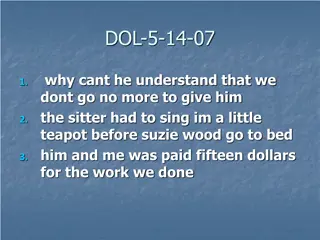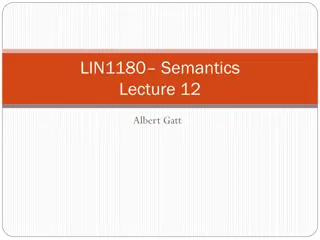Analysis of Grammatical Errors in Japanese Language Presentations by Students
This research focuses on identifying and analyzing the types of grammatical errors that occur in Japanese language presentations by students. The study aims to help students recognize and rectify errors in particle and verb usage to enhance their Japanese language proficiency and presentation skills.
Download Presentation

Please find below an Image/Link to download the presentation.
The content on the website is provided AS IS for your information and personal use only. It may not be sold, licensed, or shared on other websites without obtaining consent from the author. Download presentation by click this link. If you encounter any issues during the download, it is possible that the publisher has removed the file from their server.
E N D
Presentation Transcript
Analysis of Grammatical Errors in Japanese Language Presentations by Students No. Abstract: ABS-ICOLLITE-23158 Melia Dewi Judiasri, Dianni Risda, Herniwati, Noviyanti Aneros Departement of Japanese Language Education Faculty of Language and Literature Education Indonesian University of Education (UPI)
INTRODUCTION The research is based on the insufficient mastery of Japanese Language presentation skills, particularly in grammar proficiency. Considering this issue, it is necessary to conduct a study on the types of grammatical errors that occur in student presentations. The objective of this research is to identify the types of errors that emerge, determine the most dominant and common grammatical errors in these presentations, and understand the challenges faced during the presentation activities in the Japanese Language. By understanding the errors that arise during presentations, learners can avoid making the same mistakes in the future, and the identified error types can be addressed in future teaching.
LITERATURE REVIEW Communication skills : Rubin dan Thompson, (1994) : Effective listening skills, Effective reading skills, Effective writing skills and Effective speaking skills Error Analysis: Corder (1971): Grammatical errors, Usage errors,Convention errors Dulay, Burt, dan Krashen (1982) : tolerable errors, intolerable errors, idiosyncratic errors. James (1998) : global errors and local errors Japanese Grammar: Kuno, S. (1973) Shibatani, M. (1990) Yamazaki, M. (2005) Kida, M. dkk. (2009). Tsujimura, N. (2013)
METHOD The research method employed is a qualitative descriptive method, conducted at the Departement of Japanese Language Education at the Faculty of Language and Literature Education, Indonesian University of Education (UPI). The study involved 78 students, consisting of 15 first-year students taking shokyu dokkai 2, 43 second-year students taking chukyu dokkai 2, 20 third-year students taking chujokyu chokai 2.
FINDING AND DISCUSSION The findings of this research include the mapping of grammatical errors in Japanese Language presentations made by students, such as errors in the use of particles, verbs, appropriate use of nouns, and adjective changes. The results of this study are expected to assist students in identifying errors, strengthening their understanding and usage of Japanese grammar, and facilitating their development of better Japanese Language competence for presentations. Errors in particle usage: (wa), (ga), (ni), (de), (wo), (kara), (node), (to), (no), (made), (dewa), (mo), (nimo), (noga) Errors in verb usage: Errors in verb conjugation. Errors in the use of verb tenses. Errors in the selection of appropriate verb vocabulary. Errors in using appropriate sentence patterns.
FINDING AND DISCUSSION FINDING AND DISCUSSION Errors in noun usage: Incorrect selection of noun vocabulary. Omission of noun vocabulary. Use of noun vocabulary that does not match the sentence context. Errors in adjective usage: Errors in adjective conjugation. Errors in using appropriate adjectives. Omission of necessary adjectives in the sentence.
CONCLUSION As a conclusion from the results of this research, the following points are known: Grammatical errors in Japanese language that appear in student presentations of the Department of Japanese Language Education, Faculty of Language and Literature Education, Indonesian University of Education, are the use of particles, verb conjugation, adjective conjugation, and proper noun selection. The most common grammatical error in student presentations of the Department of Japanese Language Education is errors in the domain of morphology. Challenges encountered during Japanese language presentation activities, in general, include uncertainties in the selection of appropriate particles, vocabulary, and sentences, nervousness, and forgetting the content that should be conveyed.
REFERENCES Corder, S. P. (1967). The significance of learners' errors. International Review of Applied Linguistics in Language Teaching, 5(4), 161-170. Dulay, H., Burt, M., & Krashen, S. (1982). Language two. Oxford University Press. James, C. (1998). Errors in language learning and use: Exploring error analysis. Longman. Kida, M. et.al.. (2009). Hanasukoto o Oshieru. Kokusai Koryukikin Nihongo Kyoujuhou Shirizu- 6. Jepang: The Japan Foundation. K. Takahashi (2019) . Kuno, S. (1973). The structure of the Japanese language. MIT Press. M. Nurjanah dan T. Wahyuni (2016) Analisis kesalahan gramatika dalam presentasi bahasa Jepang oleh mahasiswa Indonesia. Rubin, R. B., & Thomson, V. (1994). Nonverbal Communication: Second Edition. New York: HarperCollins College Publishers. Saito dan T. Kato (2013) . Shibatani, M. (1990). The languages of Japan. Cambridge University Press. Sutedi, Dedi. (2009) Penelitian Pendidikan Bahasa Jepang. Bandung: Humaniora. Tsujimura, N. (2013). An introduction to Japanese linguistics. John Wiley & Sons. Yamazaki, M. (2005). Bunp k za: Nihongo no bunp o kangaeru. 3A Corporation.























